
This post is brought to you by BEHR. Color that’s True to Hue. If you feel it you can find it. Visit truetohue.behr.com
I’ve been itching to paint my bedroom a lighter color this summer. It’s been a dark gray-blue-green for about two years now. I’ve loved it, but our bedroom in Brooklyn was dark too, so it felt like time to lighten things up a little.

Paint is the least expensive and most impactful way to change the feel of a room. It can be pricey to hire out a paint job, but tackling the work yourself is really not that hard. It feels like I’ve painted something like a hundred rooms in my day, and I’ve got the process down pat at this point. I’m so excited to share with you my very best tips and tricks for choosing paint colors and then getting it all done quickly and neatly, all while spending the least amount of money necessary!
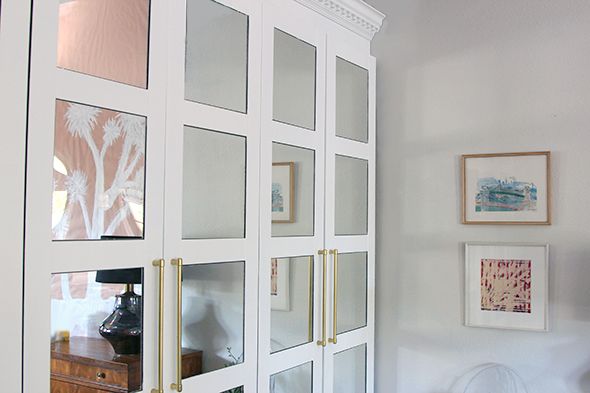
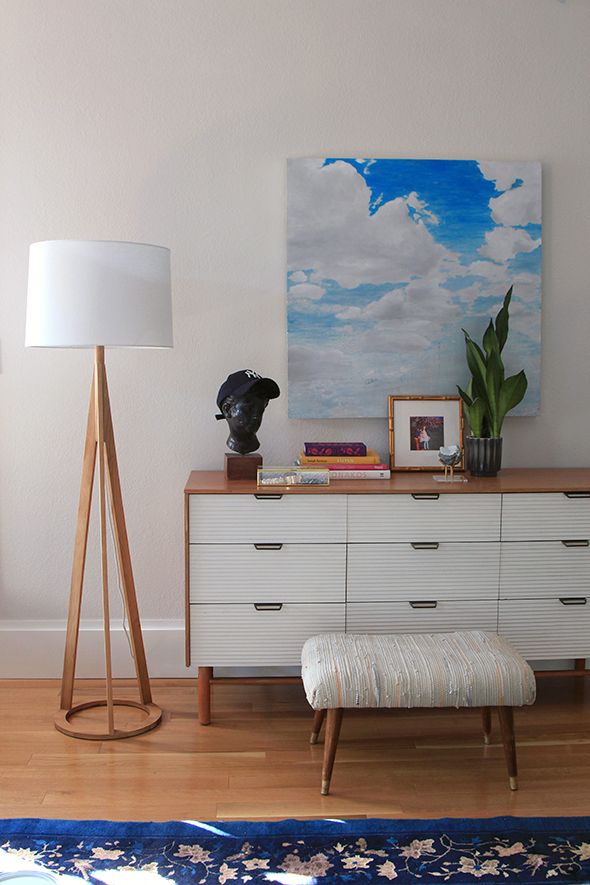
STEP 1: PICK YOUR SWATCHES
Look at Pinterest and gather a few inspiration images that help you to determine the tone and shade you’re hoping to get in your room. Unless your room has the exact same directional orientation, lighting and flooring as your inspiration room, it is a VERY risky move to copy the exact paint color of the inspiration image. At best, it will still look nice, just not the same, and at worst, some unexpected and unwanted undertones will show up and ruin the color for you.
This was my inspiration image – a soft, warm gray. Gray is gorgeous, but it is tricky to get right as you probably know if you’ve ever used it. It’s all about the undertones.
When it was time to pick my wall color, I went in to Home Depot and pulled any swatch that looked like it could maybe be a fit. It’s really important to not only see the swatches in the room that you will be painting to get an accurate reading on the color, but it’s almost equally as important to see the color in relation to your flooring.
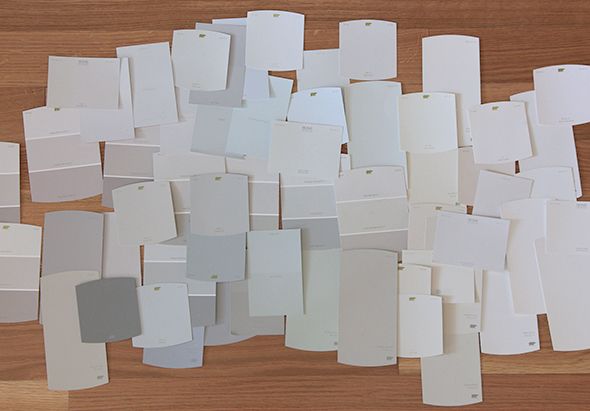
I arranged all the paint swatches on my floor roughly by undertone and by shade. This process helps to get to the bottom of what it is you might like (or don’t like) about a color. You’ll see that against your floors and in the room’s lighting, a handful of colors will emerge as the clear contenders. I wanted warm colors that didn’t have too much red or blue in them. These are the colors that ended up being my favorites:
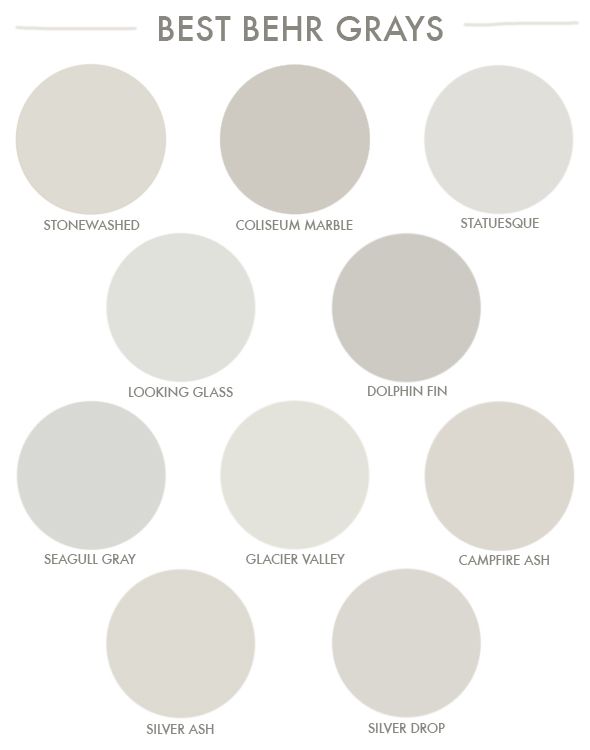
(FYI – Silver Drop and Dolphin Fin are older colors that have to be requested by name at Home Depot’s Paint Desk)

STEP 2: PAINT SAMPLE BOARDS
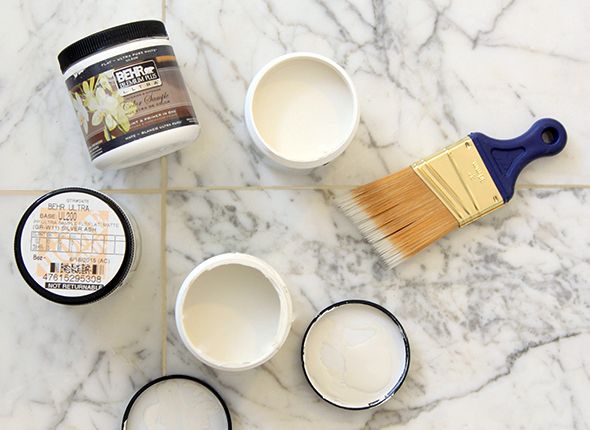
They sell foam core boards at the dollar store or at craft stores for cheap that are great to use for sample boards. You can prop them up in different parts of your room – in full sun and in shade – to get a good sense of how that color will look in all types of light.

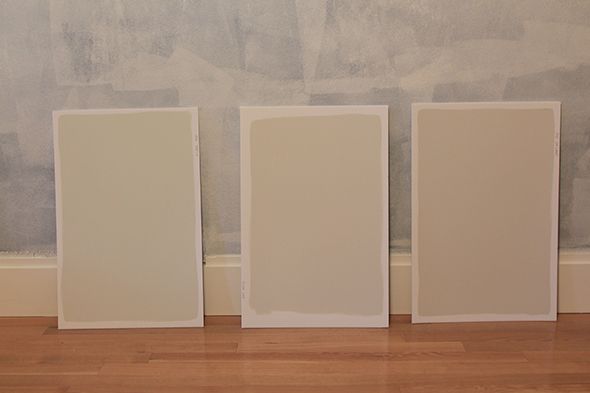
STEP 3: GATHER YOUR SUPPLIES
I keep a good stock of my favorite painting supplies on hand. These are all of my tried and true favorites that usually represent the perfect balance of performance and price.
1 – I like to buy nice roller covers, usually Purdy or Wooster brand, in their premium lines. It’s worth the extra couple of dollars for improved coverage and less lint.
2 – I don’t use tape every time, but it’s a good idea to keep some nearby. Make sure to buy the tape that has the appropriate amount of adhrsive for the application (glass or walls or floors, etc).
3 – I invested in one of these three-step stools and I use it all the time, especially for painting projects. I hardly ever have to lug in my 8′ ladder any more!
4 – These little sash brushes are cheap and good. I keep a few of them on hand at all times!
5 – I have had the same Purdy 2.5″ brush for three or four years and I love it. It holds just the right amount of paint to cut in smoothly without drips.
6 – These 5-in-1 tools do it all. I use mine for everything from scraping off old paint, to applying spackling, to opening paint cans. It’s a helpful tool to keep nearby.
7 – I used to buy big 9×12 drop cloths, but unless I’m painting a completely empty room (rarely), I much prefer small 5×5 cloths that I can scoot around furniture. The one exception is if I’m painting a ceiling and if that’s the case, then I usually empty the room anyway.
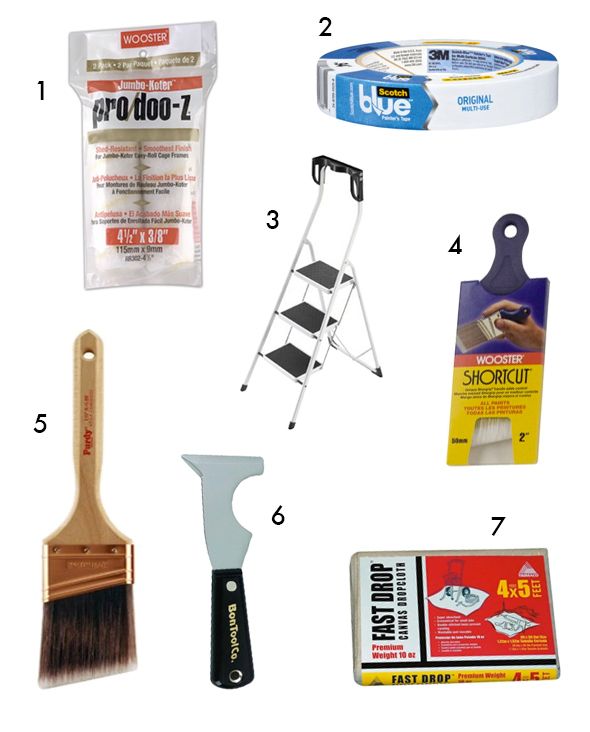
8 – I use these microfiber cloths all day, every day. They are great for cleaning and they are so helpful for prepping walls and trim before painting.
9 – While I’m painting, rather than getting paint on my favorite microfiber cloths, I use baby wipes to clean up drips or mistakes. Works like a charm!
10 – I keep this paint brush cleaning tool handy to help me prolong the life of my brushes. It’s important to not get too aggressive on the bristles though or you’ll start losing them!
11 – This is the best caulk to use for moldings and trim! It dries quickly, without a sheen and it’s completely paintable! I don’t like the silicone version of the same caulk.
12 – This spackling goes on pink and turns white when it is completely dry and ready for paint. It works great for filling in nail holes.
13 – I use this paint shield instead of painter’s tape. I feel like it saves me a TON of time and cash!
14 – I don’t like wearing latex gloves while I’m painting, so I usually end up with paint all over my hands. This soap works like a dream, even for oil-based paints!
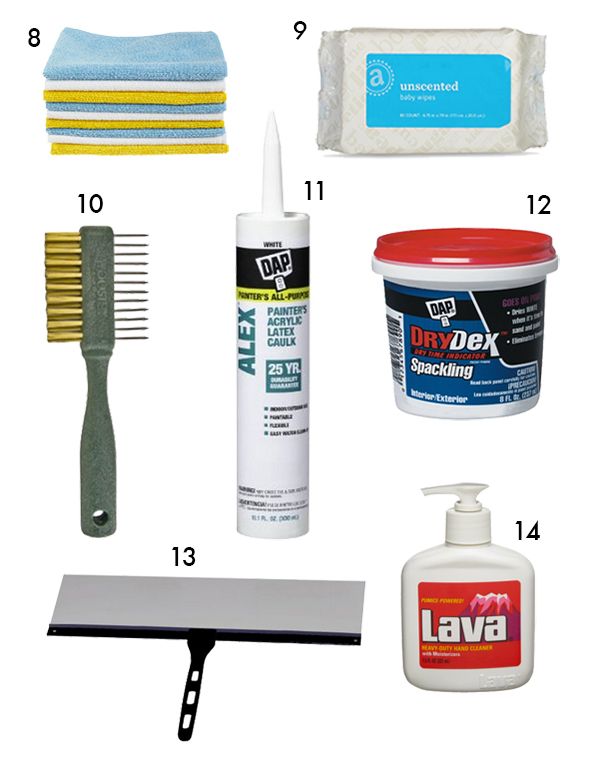
STEP 4: PREP YOUR WALLS
It usually doesn’t take much to get your walls ready for paint. Fill all of the nail holes with pink-to-white spackling and re-caulk any parts of the moulding that need it with ALEX caulk. Then use a wet microfiber cloth to wipe down any smudges on the walls and especially all of the trim. You can use the microfiber cloth to wet sand the spackling and caulk rather than make a dusty mess with a sanding block. While that’s drying, it’s a good idea to tackle any of the taping off you’ll need to do before starting. I only taped off the mirrored panes on our armoire this time.
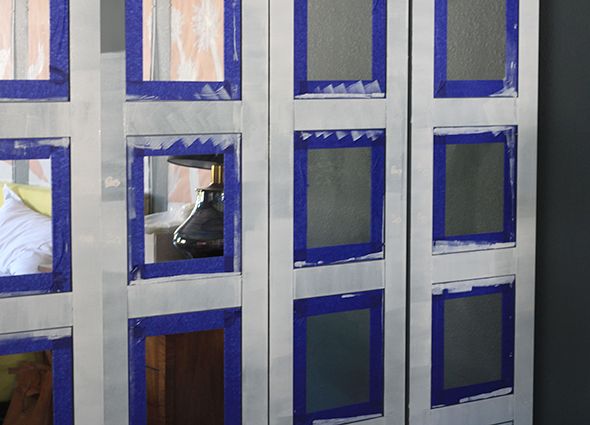
I don’t usually need a primer when I’m painting with BEHR because it is a paint and primer in one, but I had some extra primer on hand and the color on our walls was so, so dark. But after one coat of primer I only needed to follow up with one coat of the BEHR.

STEP 5: PAINT TRIM
Before even breaking into the wall color though, it’s a good idea to paint the trim first using a damp 2.5″ angled brush. By painting the baseboards, casings and crown first, you can be as messy as you want on the wall. No need to use rolls and rolls of pricey painter’s tape. When I’m painting the baseboards and the crown I use a shield to protect the floor or the ceiling as I go. If there are any leaks, I just use baby wipes to clean up the messes as I go. It is a fast and very easy way to get through what can be the most tedious part of painting a room!
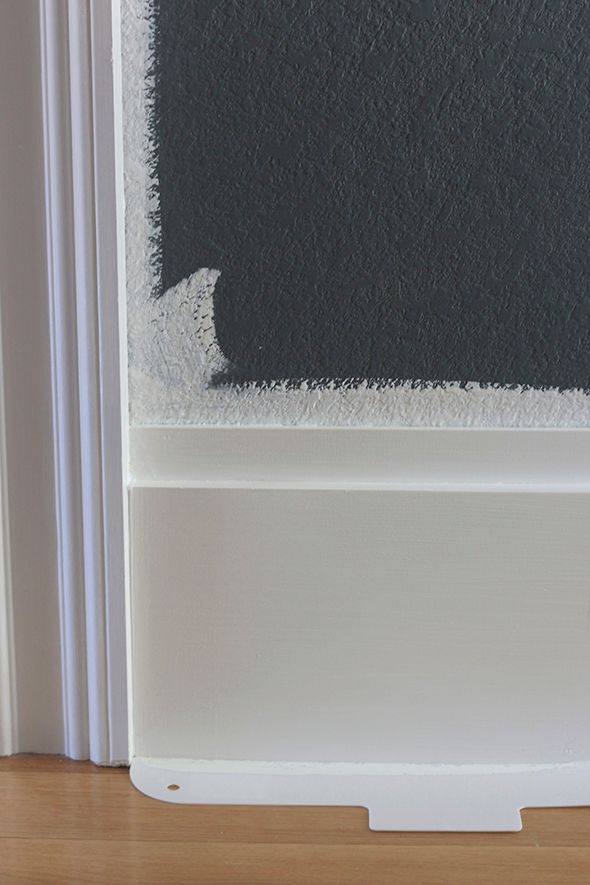
STEP 6: ROLL ON PAINT
Believe it or not, the hardest parts are over at this point! Rolling on and cutting in will go SO fast if you’re ready and all the furniture has been pushed to the center of the room. This is when I break out my 5×5 ft drop cloth and my triple step stool. Both are just big enough to do the job, but are small enough to move very easily.
The best and most efficient way to roll is to start with a damp (not wet) roller cover, which helps the roller to soak up just the right amount of paint. Load your roller, then starting at the ceiling and working your way to the floor, paint a 3×3′ “W” and then fill in the in between also at an angle. Resist the urge to go over the area multiple times, which will just pick up paint rather than deposit it. Then load the roller again and paint another “W”below the one you just finished, and continue on, column after column, top to bottom. This approach goes unbelievably fast and always makes for an even coat the first time that won’t be too thick or too thin. I have textured walls in my bedroom, which can be a beast to paint, but the “W” technique makes it so there are never any missed spots the first time.
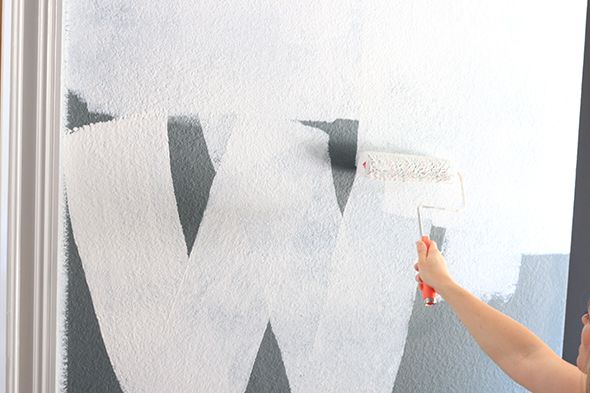
STEP 7: CUT IN
Once all of your walls have been rolled, use a damp 2″ sash brush to cut in along your trim. I have a pretty steady hand, so I don’t bother with painter’s tape here. I just keep the baby wipes handy to wipe up mistakes as soon as they happen.
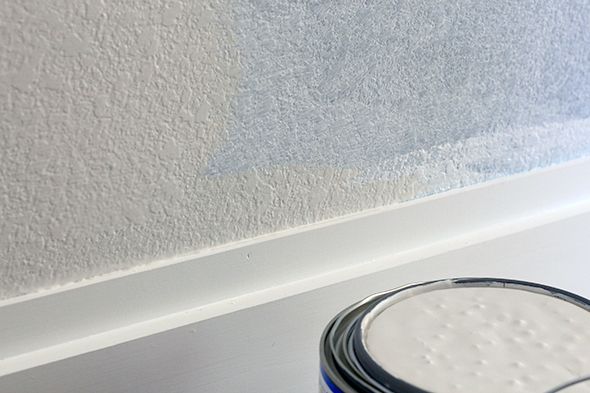
If you do need to use painter’s tape, I like to pull it off almost immediately after painting. If you let the paint dry on the tape you risk some of the paint pulling off with the tape.
Also, if you need to stop and take a break for a little while, put your brush in a sandwich baggie and stick it in the freezer to slow the drying process! This works for rollers too.
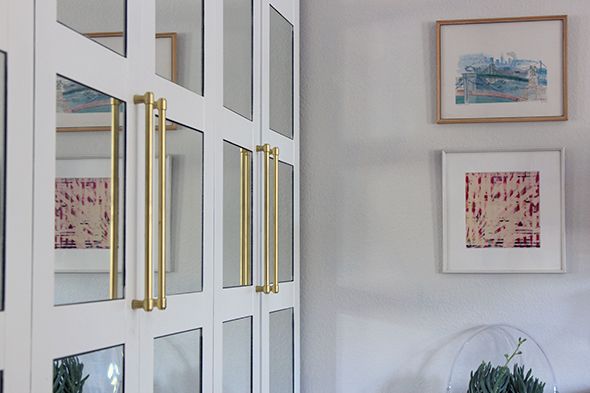



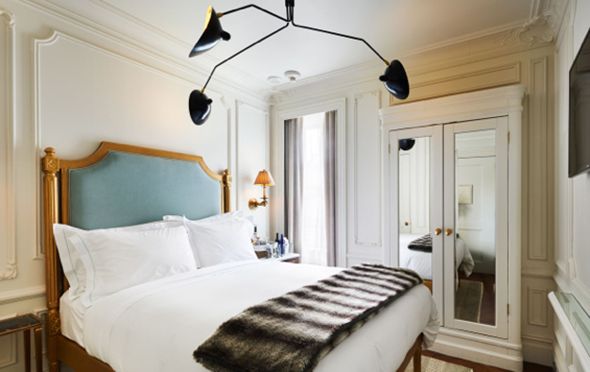


Yep, you nailed it! I love the color you chose. You are more disciplined than me using the swatches and tests on the foam core boards. I should do that…. I'm too impatient to just get paint on the wall but I think it would really pay off to do the large test swatches like you do. I typically just live with whatever color I chose, whether it was just what I wanted or not quite. :) I agree with all your other advice; we always just do the painting ourselves and we have steady hands too. I don't mind painting, but then, we have the good supplies like you do which make it easier. I also second what you said about good brushes and good roller covers being worth the extra couple dollars. Thanks for putting together this comprehensive post!
I really like the paint color and should definitely invest in some of the tools like the step ladder and 5-in-1 tool. I always lose the key they give at Home Depot when buying paint and never want to bring the ladder in from the garage.
Love the new color!
Love the new color! I am a huge fan of grey paint, but it does take a little extra time to find just the right color. I think I spent a couple weeks and bought 4-5 test pots before I found the right shade for our living room. The baby wipes are a great idea, I use old torn up t-shirts to wipe up drips and then toss them when I am done. (BTW that cloud painting is gorgeous!)
Steph
Looks great! We are looking to do a similar paint switch in our master (though we have nearly neon aqua walls from the previous owner, instead of dark ones to contend with). I was so surprised by the paint that looked best! Always worth it to swatch, in my opinion :) Thanks for sharing your tips!
This post is so thorough, and I'm sure it was a ton of work to put together. I'm still kind of wishing you'd shared your process on deciding on a matte paint finish in this space. Your inspiration photo looks like it used something more reflective, and that's always one of the hardest decisions for me since having kids. Because, you know, grimy little fingers that touch every stinking thing.
i admit it too! i toss the roller sponge, but baby the brushes. sooo impossible to pick a color without test swatches first. also? i use cereal box cardboard as 'tossable' shields as i go. beautiful shade up ended up with. and love the hip floor lamp :)
Beautiful! The new pulls on the PAX are stellar. Please share some dets…and I have to ask, did you leave the insides dark? That could look so pretty when the doors are open.
Hi Em! I used a flat sheen in here, but usually choose an eggshell in the rooms the kiddos are in often! We have a high texture on the walls in here which looks best in a matte finish I think. I love a good gloss though in rooms with pretty moldings!! :)
Hi Kimberly! They are from IKEA! I spray painted them gold first though. :) I think I have some photos of the process and will post them if I do! xo
Looks good, but I'd love to see more photos of the paint in the entire room ��
Thanks Joanna! More photos are coming! We are waiting for our new bed to arrive and then I'll share the rest of the room. :)
A different painting question…
Where did the clouds painting source from?
Thank you!
Lots of painting to be done here in kc! Yhanks for the tios!
Love the new color! I'm not sure if it's me, my monitor, or the lighting or reflection in your pics, but it almost looks like you can still see the old paint through the new one? Does it need another coat?
I love Dolphin Fin! I tested out 8 different grey's around my house before choosing it for my hallways and foyer.
So pretty!!! I am loving this lighter color! (Who am I kidding, I loved the dark color too!)
I also just sent this post to The Husband because he gives me SO MUCH FLACK for having eleventy-million paint swatches taped on the floor or wall and a couple of sample colors. I'M DOING IT RIGHT, HONEY! SEE?!?! :)
xox
Would you recommend a color from Benjamin Moore that is similar to Silver Drop?
Thank you!
Jill
All great tips. And a very timely post since I need to finish painting my living room this weekend.
Thank you for sharing your painting skills with great detail. As usual, your writing is clear, friendly, and a delight to read. Saving this column for my next project, for sure!
It looks lovely! And so fresh. What color did you use for your trim? TIA ????
Looks great! Where is that lamp with the wooden base from? Love it!!
Bravo! This is thee best painting tips post I've ever read.
Thank you
I'm a parttime DIYer and have painted several pieves of furniture … my biggest questions is regarding the clean up: do you just rinse your brushes in the sink?
what about the chemicals of the paint getting in the water?
thx!
Love the new freshened-up look! Amazing–the power of paint, isn't it? I love the new color, but can't seem to find the name of the old color (the dark gray-blue). It's just what I need for a MBR feature wall. Can you share the name? Thank you so much!!
Love the new look & the larger bar's for hardware! I'd love to see a shot with the cabinets open when you finish the room.
– Amanda
lifeonlinton.com
Hi guys!
The trim color is BM Chantilly Lace (to match the rest of the house). Former bedroom color was Knoxville Gray. A great match to Silver Drop would be Classic Gray. Both are soft and warm! :)
Loes – you can rinse your brushes outside in a bucket and let it dry out and toss it after maybe?
Floor lamp is from Crate and Barrel!
Cloud painting is by Tara Andris. A charished favorite of mine! :)
xo
Hi Jenny
Thank you for your reply. I tried Classic grey and its pulling very warm on my walls which get a lot of sunlight. Any cooler whites you would suggest with a hint of grey? Im trying to avoid anything too blue or lavender. I have a light grey sofa.
Thanks so much!!
Jill
This post might have just been the push I need to repaint my not-terrible, but yellowy off-white walls! So many great tips – love the paint shield/baby wipes combo to save taping everything!
One tip I got from a lovely woman at the paint counter at Home Depot in seattle that changed everything for me was to use the smaller size "hotdog" rollers, even on your walls. The coverage is quite similar to a regular roller, it's much easier to manage and you're not left feeling nearly as fatigued. It's a serious game changer – give it a try!
Light and love,
Janessa
Thanks for the great tips! I hope it's not too late to ask but I'm confused about the order of events. I've always cut in along th edges first, then rolled (as close to edges as possible) for a nice smooth finish. But it sounds like you roll first and then cut in. Have I been doing it wrong all these years? Or is this personal preference? And if it is your preference, can you explain why it works better? Thanks!
Jenny–I read this post initially when you posted it, knowing I would be painting in the near future. It was an invaluable resource! Although I have painted many rooms, I had never tried going tape-less; it was a delight! It took me a little bit to get the hang of holding up the shield with one hand and painting with the other, but now I love it. And the baby wipes–brilliant! I also tried caulking for the first time, thanks to you. I got a disposable tube of the same caulk rather than the gun set-up. Thank you so much for this post and your tips. One tip I would add was given to me by a friend. Use a cheap synthetic artist's brush to touch up flubs especially on the ceiling (overpainting with the wall paint, for instance).
Hi – Can you share your old bedroom color? Thank you!
Nevermind – found it! Comments didn’t load originally…
I have been doing my own painting for the past twenty + years and it appears you have it down to a science as well. That said; hope you do not mind me adding another wonderful colourful from Behr which is ‘Ashen Tan’ that is the perfect choice for those who are torn between choosing a gray or a beige as its a chameleon of sorts depending upon the time of day and/or lighting in the space. In a nutshell, it is a mix of gray & beige thus is somewhat warm & is perfect for rooms where there are hard surfaces like a bathroom or rooms with hardwood flooring plus is so neutral that there are abundant accessory colours that will go well with it. -Brenda-
P.S.: Am going to also add, to save yourself of the agony of having to re-paint a space (or a piece of furniture); always do up a sample board first. and move ‘it’ around during different times of the day and/or with variable artificial lighting. *No swatches on walls allowed … ☺.* As for furniture the same rule applies as undertones have been known to play tricks when it comes to the lighting in a space.
I love this! I painted Silver Drop throughout my condo five years ago; it is the perfect neutral yet slightly warm grey which goes well with my tan carpet, warm wood bedroom furniture, white ceramic tile floors in the living room, dining, and kitchen, and it really pops against my Swiss Coffee crown moulding.
These are some great tips, and I appreciate your advice to try sample boards before painting the whole room. My husband and I just moved into a new house, and I want to repaint several of the rooms. I’ll definitely make sure to use sample boards and test them in the actual lighting of the room before I commit and begin painting. Thanks for the great post!
The sample boards! What a great idea. I have been struggling with dinky patches for years.
Nothing can spoil like stains.But Nice tips for Hoteliers for their good job. I found one more here. I think it will help you.
https://www.hotelierjobz.com/blog/
Try cutting in before rolling. You will get less brush marks and more stipple look from the roller as close as you can to all moulding.
The walls in our new build have already been painted their final color so this trim painting after install is tough!! What sheen are you using for trim? I’m having horrible roping/brush stroke problems with SW Extra White in a semi-gloss finish. Even tried an extender without any luck. I’d love to hear your advice and if you’ve run into obvious brush stroke issues. Thanks so much for any advice you can send my way ♥